Explosive Agility Workout
FREE WRESTLING WORKOUT!
Download by entering below

Explosive Workout With Nick Gwiazdowski
Early in the morning, we started with having Nick do power cleans to wake up his nervous system. The goal was to get Nick to produce power. Plus, the movement is easy for Nick because he has been doing the exercise for a decade-plus. The goal was to hit 110 kilos for a nice, easy triple.
From there, we wanted to move into stability work to wake his nervous system up even further with minute movements, especially with his feet, so that when we move into the jump session he has greater proprioception.
The Most Difficult Warm Up Movement EVER
The first proprioception movement was a doozy. Nick had to get in a lunge position. His front foot balancing on a PVC pipe and his back foot on a pad, Nick needed to lunge down and, as he stood up the lunge, lifted his back foot off the pad. As he went back into the lunge he had to land the back foot on the pad and redo the movement for five lunges.
After the fifth lunge, Nick needed to bring the back leg onto the PVC pipe to walk forward on the PVC pipe and then backward on the PVC pipe. The big goal, after the backward walk, was to reposition the other leg on the back pad and do the lunges with the other leg. The whole goal of this is to wake up the feet and the quads a little bit.
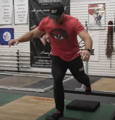
Ankles Ready
Next thing, with the shoes off, Nick had to walk down the turf on his tippy toes. Walking back, he had to walk on his heels with his toes up in the air. In the third movement, I had Nick step heel, heel, and then raise onto his tippy toes (both feet together) to wake up the ankles so that when he started jumping his feet were reacting as quickly as possible. The next movement was the windshield wiper ankle movement. The windshield wiper movement is lateral. I had Nick do five reps to the right and then five reps to the left.
Dynamic Plate Plants (Barry Sanders Step)
The idea of this movement is to mimic planting and coming back. To do the movement, Nick had to hold a plate like a driving wheel. Jumping forward, the whole point is to land on a single leg, turn the hip, but keep the chest in the direction of jumping forward. Pause in the landing by sticking and not crumbling forward. Putting the plate out with the upper body makes the movement more challenging.
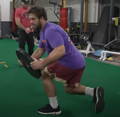
Side Drop To Mini Hurdle Bounds
Nick had to complete a side depth drop from a box of around 12”. Upon landing, he needed to complete two bounds over mini hurdles. The bounds and lateral depth drop were all bilateral movements.
The lateral depth drops need to be completed from both directions, so we had a box set up to the right and to the left of the mini hurdles.
The point of the two movements being combined had to do with deceleration unilaterally and power production bilaterally to accelerate as quickly as possible. The dynamic plate plants are essentially a reflexive strength movement. For a wrestler, the point of the movement is to better prepare Nick to set up a shot or for Nick to defend a shot.
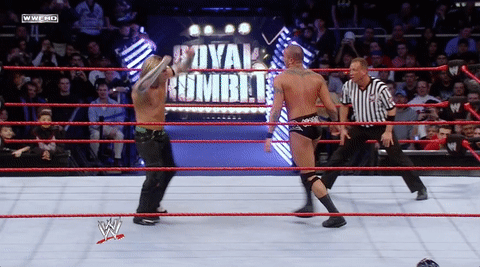
Benefits Of Plyometrics And Reflexive Strength Training
In wrestling, especially someone like Nick who is much older now at this point in his career and doesn’t need as much max strength because he has a strong base and two decades of wrestling and training under his belt so at this point Nick needs to focus on minute details to gain the smallest fraction of an increase in his overall performance. That is where learning the skills of co-contractions and learning how to be more stable at higher speeds will pay off a lot more.
Yes, Nick still needs to do heavier squats and heavier benches and stuff like that, but at this point in his career, and wrestling in general as an open skill sport, it is more important to consider all the different factors, movements, and mobility requirements. Nick learning different positions and different rates of coordination is extremely important.
Right Leg, Left Leg, Swing
This is an advanced movement. With a plate in hand like a driving wheel, the movement begins by stepping over a mini hurdle and landing on a single leg. The other leg, the one closest to a side mini-hurdle, then steps laterally over the adjacent mini-hurdle. Upon landing on the single leg, the plate is swung up and the non-grounded leg assumes a hip lock position. The hip lock position needs to be held for a solid pause.

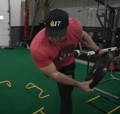

For this movement, I used the principle of chunking with the first movement (the Barry Sanders step) to teach the first part to now have Nick cut, land, and into a hip lock with the plate. The idea is to try and confuse the body as much as possible to get his body more reactive on the mat to have better offensive and defense while being lighter on his feet.
Bilateral Hurdle Hop To Unilateral Mini Hurdle Lateral Step To Hop Back Series
This series of jumps is no joke. It begins with a bilateral hurdle hop. Land on two legs. Upon landing, gracefully step over the mini hurdle and land unilaterally. Quickly rebound from the unilateral step and laterally bound off the single leg. Land bilaterally and immediately bound over the next hurdle to repeating the sequence.



The Struggle
Nick is a world-class athlete. He STRUGGLED with these movements. His body had to think through the movements. His body had to chunk the movement out and think through the pieces to get his body to execute it as well as possible. In the beginning, Nick’s body was rigid, like a baby learning how to walk. As he continued to work through the movements, he got better and better and smoother and smoother. The noise in the body quitted as his body figured out what to do.
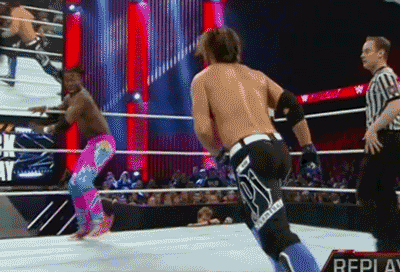
Sled Work
Nick’s quads got lit up. He drove the sled forward the length of the turf and then walked backward pulling the sled. He did this repeatedly as a means of conditioning. One variation Nick completed occurred pushing the sled forward. Nick would drive the sled forward while keeping the same leg forward and the same leg back the entire length. He would then alternate which leg was forward and which leg was back the next time going forward. Nick did this variation to stimulate the act of taking a shot.
The variation created massive amounts of fatigue. Doing this helped simulate the feeling that occurs late in a wrestling match. The sled is a lot of strength-endurance work. And with wrestling, strength-endurance is key. Another big key is to keep the hips lower so that the body can drive into the sled for an opponent’s hypothetical shoulders.
Recap
We started with some big lifts, went into proprioception work, and then did some different reflexive strength work to train co-contractions, deceleration, plyo work, and finished up with some sports-specific sled work.
Nick’s biggest takeaway from the workout was the correlation between the muscle movements collaborating with the brain to move faster. Though Nick is a wrestler, he did note that fast movements correlate to every sport.
Related Posts
Blog Topics

Yo, It's Dane
Welcome to the Garage Strength Blog, where it is my goal to provide you with the experience and knowledge I've gained in the strength and conditioning world over many years of learning from both successes and failures. I train elite-level athletes in a multitude of sports from the high school to professional levels, already producing 5 Olympics and 30+ National Champions. If you want to be the next champion I train, check out my strength programs below!
Start Training With Me

Join for free educational videos EVERY WEEK on strength coaching and athletic performance


